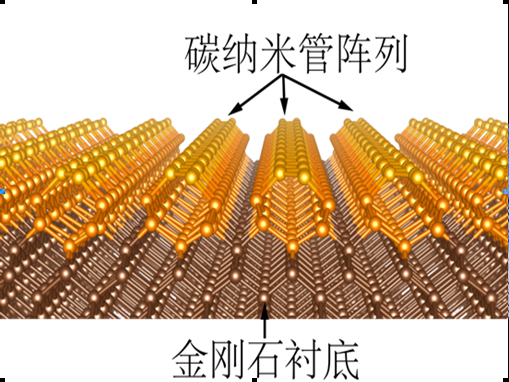Abstract In a significant breakthrough, the State Key Laboratory of Superhard Materials at Jilin University has advanced research on a "new method for surface reconstruction and self-assembled carbon nanotube arrays on diamond surfaces." The findings were published on April 16, 2014, in *Nature Communications*. This study was supported by several key funding sources, including the National Natural Science Foundation of China's Outstanding Youth Fund, the Surface and Key Funds, the 973 Program from the Ministry of Science and Technology, and the Education Minister Jiang Scholar Research Program. 
The research was conducted by a team from Jilin University, including Dr. Lu Shaohua, Dr. Wang Yanchao, Dr. Liu Hanyu, and Professor Ma Yuming, along with Dr. Miao Maosheng from the Beijing Computing Science Center and the University of California. They developed a novel simulation approach to surface reconstruction and discovered that a self-assembled carbon nanotube array can form on the diamond surface. This breakthrough suggests that such surfaces could serve not only as substrates for integrating devices but also as essential components in functional systems. The study paves the way for the seamless integration of diamond and carbon nanotubes, offering new perspectives for the development of diamond-based semiconductor technologies.
The team employed a multi-objective group intelligence optimization algorithm, incorporating two-dimensional space group structure constraints and electronic counting rules to develop a new global surface reconstruction simulation method. This innovative approach allows for intelligent structural search without relying on pre-existing surface structures. Drs. Lu Shaohua and Wang Yanchao integrated this method into a program module within the CALYPSO structure prediction software package, which was developed by Professor Ma Yuming’s research group.
Applying the newly developed CALYPSO method to the diamond (100) surface, the researchers unexpectedly discovered a novel class of self-assembled carbon nanotube arrays, resembling an ordered arrangement of carbon nanoparticles. These nanotubes are strongly bonded to the diamond (100) surface. Under normal conditions, the structure resembles traditional dimer configurations, but under high temperature or compressive stress, the carbon nanotube array becomes more stable. This unique structure combines the high thermal conductivity of diamond with the high carrier mobility of carbon nanotubes, offering excellent thermal stability and self-assembly properties. (Source: State Key Laboratory of Superhard Materials, Jilin University)

The research was conducted by a team from Jilin University, including Dr. Lu Shaohua, Dr. Wang Yanchao, Dr. Liu Hanyu, and Professor Ma Yuming, along with Dr. Miao Maosheng from the Beijing Computing Science Center and the University of California. They developed a novel simulation approach to surface reconstruction and discovered that a self-assembled carbon nanotube array can form on the diamond surface. This breakthrough suggests that such surfaces could serve not only as substrates for integrating devices but also as essential components in functional systems. The study paves the way for the seamless integration of diamond and carbon nanotubes, offering new perspectives for the development of diamond-based semiconductor technologies.
The team employed a multi-objective group intelligence optimization algorithm, incorporating two-dimensional space group structure constraints and electronic counting rules to develop a new global surface reconstruction simulation method. This innovative approach allows for intelligent structural search without relying on pre-existing surface structures. Drs. Lu Shaohua and Wang Yanchao integrated this method into a program module within the CALYPSO structure prediction software package, which was developed by Professor Ma Yuming’s research group.
Applying the newly developed CALYPSO method to the diamond (100) surface, the researchers unexpectedly discovered a novel class of self-assembled carbon nanotube arrays, resembling an ordered arrangement of carbon nanoparticles. These nanotubes are strongly bonded to the diamond (100) surface. Under normal conditions, the structure resembles traditional dimer configurations, but under high temperature or compressive stress, the carbon nanotube array becomes more stable. This unique structure combines the high thermal conductivity of diamond with the high carrier mobility of carbon nanotubes, offering excellent thermal stability and self-assembly properties. (Source: State Key Laboratory of Superhard Materials, Jilin University)
Australian Standard Series Doors And Windows SeriesAustria
Australian Standard Doors,Quality Windows,Trade Series Products
Guangdong Jihua Aluminium Co., LTD , https://www.jihua-alu.com